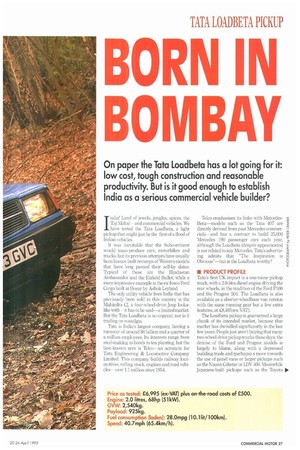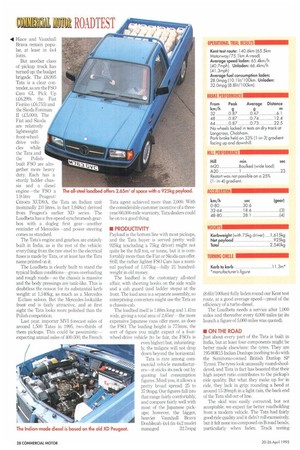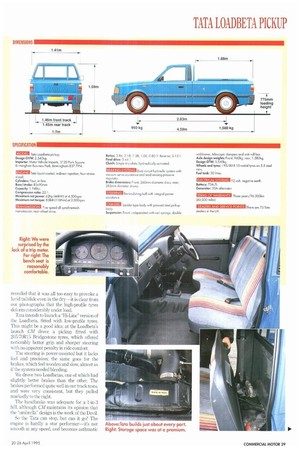BORN BOPA AY
Page 29

Page 30

Page 31

Page 32

If you've noticed an error in this article please click here to report it so we can fix it.
On paper the Tata Loadbeta has a lot going for it: low cost, tough construction and reasonable productivity. But is it good enough to establish India as a serious commercial vehicle builder?
Indial Land of jewels, jungles, spices, the Taj Mahal and commercial vehicles. We have tested the Tata Loadbeta, a light pickup that might just be the first of a flood of Indian vehicles, It was inevitable that the Subcontinent would mass-produce cars, motorbikes and trucks, but its previous attempts have usually been licence-built revamps of Western models that have long passed their sell-by dates. Typical of these are the I Iindustan Ambassador and the Enfield Bullet, while a more impressive example is the ex-Iveco Ford Cargo built at Ilosur by Ashok Leyland.
The only utility vehicle from India that has previously been sold in this country is the Mahindra Cl, a four-wheel-drive Jeep lookalike with it has to be said—a limited market. But the Tata Loadbeta is no copycat, nor is it trading on nostalgia.
Tata is India's largest company, having a turnover of around $6 billion and a quarter of a million employees. Its interests range from steel-making to hotels to tea planting, but the best-known arm is Telco—an acronym for Tata Engineering & Locomotive Company Limited. This company builds railway locomotives, rolling stock, engines and road vehicles over 1.1 million since 1954.
Telco emphasises its links with MercedesBenz—models such as the Tata 407 are directly derived from past Mercedes commer
cials and has a contract to build 25,000 Mercedes 190 passenger cars each year, although the Loadbeta (despite appearances) is not related to any Mercedes. Tata's advertising admits that "The Inspiration is Obvious"—but is the Loadbela worthy?
• PRODUCT PROFILE Tata's first UK import is a one-tonne pickup truck, with a 2.0-litre diesel engine driving the rear wheels, in the tradition of the Ford P100 and the Peugeot 504. The Loadbeta is also available as a shorter-wheelbase van version with the same running gear but a few extra features, at £8,495 (ex-VXf).
The Loadbeta pickup is guaranteed a large chunk of its intended market, because that market has dwindled significantly in the last few years. People just aren't buying that many two-wheel-drive pickup trucks these clays: the demise of the Ford and Peugeot models is largely to blame, along with a depressed building trade and (perhaps) a move towards the use of panel vans or larger pickups such as the Nissan Cabstar or UN 400. Meanwhile Japanese-built pickups such as the Toyota lo
Hiace and Vauxhall Brava remain popular, at least in 4x4 form.
But another class of pickup truck has turned up: the budget brigade. The £6,995 Tata is a clear contender, as are the FS0 Caro GL Pick Up (£6,299), the Fiat Fiorino (£6,755) and the Skoda Foreman II (£5,000). The Fiat and Skoda are relatively lightweight front-wheeldrive vehicles while the Tata and
the Polishbuilt FS0 are altogether more heavy duty Each has a sturdy ladder chassis and a diesel engine—the FS0 a
1.9-litre Peugeot/ Citroen XUD9A, the Tata an Indian unit (nominally 2.0 litres, in fact I ,948cc) derived from Peugeot's earlier XD series. The Loadbeta has a five-speed synchromesh gearbox with a dogleg first gear—another reminder of Mercedes—and power steering comes as standard.
The Tata's engine and gearbox are entirely built in India, as is the rest of the vehicle: everything from the raw steel to the electrical fuses is made by Tata, or at least has the Tata name printed on it.
The Loadbeta is clearly built to stand the typical Indian conditions—gross overloading and rough mads—so the chassis is massive and the body pressings are tank-like. This is doubtless the reason for its substantial kerb weight: at 1,540kg, as much as a Mercedes E-class saloon. But the Mercedes-lookalike front end is fairly attractive, and at first sight the Tata looks more polished than the Polish competition.
Last year, importer MVI forecast sales of around 1,500 Tatas in 1995, two-thirds of them pickups. This could be pessimistic— expecting annual sales of 400-500, the French
Tata agent achieved more than 2,000. With the considerable customer incentive of a threeyear/60,000-mile warranty', Tata dealers could be on to a good thing.
• PRODUCTIVITY Payload is the bottom line with most pickups, and the Tata buyer is served pretty well: 925kg (excluding a 75kg driver) might not quite be the full ton, or tonne, but it is comfortably more than the Fiat or Skoda can offer. Still, the rather lighter FSO Caro has a nominal payload of 1,075kg—fully 21 hundredweight in old money.
The loadbed is the customary all-steel affair, with sheeting hooks on the side walls and a cab guard (and ladder stops) at the front. The load area is a separate assembly, so enterprising converters might use the Tata as a chassis-cab.
The loadbed itself is 1.88m long and 1.41m wide, giving a total area of 2.65m—the more expensive Japanese vans offer more, as does the FS. O. The loading height is 775mm, the sort of figure you might expect of a fourwheel-drive vehicle (to be fair, the FSO's is even higher) but, infuriatingly, the tailgate will not drop down beyond the horizontal.
Tata is rare among commercial vehicle manufacturers—it sticks its neck out by quoting fuel consumption figures. Mind you, it allows a pretty broad spread: 25 to 37.9mpg. Our figures fall into that range fairly comfortably, and compare fairly well with most of the Japanese pickups; however, the bigger, Aheavier Vauxhall Brava
Doublecab 4x4 (in 4x2 mode) managed 32.7mpg (8.61it/100km) fully laden round our Kent test route, at a good average speed—proof of the efficiency of a turbo-diesel.
The Loadbeta needs a service after 1,000 miles and thereafter every 6,000 miles (at its launch a figure of 5,000 miles was quoted).
• ON THE ROAD Just about every part of the Tata is built in India, but at least four components might be better made elsewhere: the tyres. They are 195/80R15 Indian Dunlops (nothing to do with the Sumitomo-owned British Dunlop SP Tyres). The tyres look unusually round-shouldered, and Tata in fact has boasted that their high aspect ratio contributes to the pickup's ride quality But what they make up for in ride, they lack in grip: rounding a bend at around 15-20mph in a light rain, the back end of the Tata slid out of line.
The skid was easily corrected, but not acceptable: we expect far better roadholding from a modern vehicle. The Tata had fairly good ride quality and it didn't mil excessively, but it felt none too composed on B-road bends, particularly when laden. Track testing revealed that it was all too easy to provoke a lurid tailslide even in the dry—it is clear from our photographs that the high-profile tyres deform considerably under load.
Tata intends to launch a "Hi-Line version of the Loadbeta, fitted with low-profile tyres. This might be a good idea: at the Loadbeta's launch CM drove a pickup fitted with 205/70R15 Bridgestone tyres, which offered noticeably better grip and sharper steering with no apparent penalty in ride comfort.
The steering is power-assisted but it lacks feel and precision: the same goes for the brakes, which feel wooden and slow, almost as if the system needed bleeding.
We drove two Loadbetas, one of which had slightly better brakes than the other. The brakes performed quite well in our track tests, and were very consistent, but they pulled markedly to the right.
The handbrake was adequate for a 1-in-3 hill, although CM maintains its opinion that the "umbrella" design is the work of the Devil.
So the Tata can stop, but can it go? The engine is hardly a star performer—it's not smooth at any speed, and becomes asthmatic
at high speed. The gearchange is acceptable, and the dogleg first speed can be safely ignored unless the vehicle is laden. Our first example could barely reach the motorway speed limit, but the second felt able to reach Tata's claimed maximum of 125km/h. Even so, its laden 0-80km/h time of 30.6 seconds was disappointing-it's comfortably beaten by the old Perkins Prima-powered Leyland Daf 200, for instance.
• CAB COMFORT
The Loadbeta's cab is not promising: there's a bench seat covered in stripy velour, and some of the most plastic-looking plastic trim we've ever seen. Clearly the seat provides little lateral support (neither do the tyres...) but it proved to be comfortable enough for a couple of hours' driving.
The rest of the cab is an odd mixture of features: there is a tilting steering wheel and a rev-counter, but hardly any storage space and (bafflingly) no trip-meter. Where other manufacturers would fit blanking plugs, there are non-functioning rocker switches.
Visibility is good, as one would expect of a pickup, but the large wing mirrors seemed warped, giving a distorted "hall of mirrors" effect to the rear view The windscreen wipers are two-speed, with an intermittent wipe function; rather too intermittent, as it happens-travelling on the 1125 at night, in heavy traffic and heavy rain (of course) they decided to give up the ghost. Fortunately, replacing the (Tata) fuse seemed to do the trick.
• SUMMARY
The Tata Loadbeta is a frustrating vehicle: several people remarked on its good looks, it's well finished, it performs perfectly well on paper. and the price is right. But its handling is poor, its performance is middling andperhaps most significantly-different examples of this vehicle have proved to be worryingly inconsistent. Did we test a good one or a bad one There's no question that the Tata's excellent warranty and bombproof construction will win it friends in the cost-sensitive construction trade, but we have yet to be convinced. One day India may lead the world in vehicle manufacture-but not just yet.
E by Toby Clark




























































































